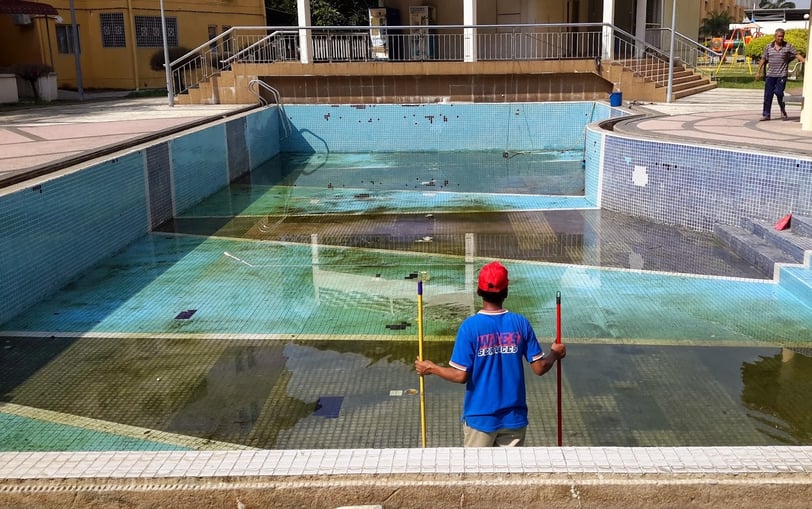Swimming Pool Maintenance
Proper pool maintenance not only extends the life of your pool but also protects your investment
2/3/20242 min read


How to Maintain Your Swimming Pool: A Complete Guide
Owning a swimming pool can provide endless fun and relaxation, but it also comes with the responsibility of regular maintenance to ensure it stays clean, safe, and enjoyable. Proper pool maintenance not only extends the life of your pool but also protects your investment. Here's a step-by-step guide to maintaining your swimming pool.
1. Test and Balance Water Chemistry
Maintaining proper water chemistry is essential for a clean and safe swimming environment. Regularly test your pool water for the following:
· pH Levels: Keep the pH between 7.2 and 7.8. A balanced pH prevents irritation to swimmers and protects pool equipment.
· Chlorine Levels: Maintain chlorine levels between 1 and 3 parts per million (ppm) to kill bacteria and algae.
· Alkalinity: Aim for a range of 80-120 ppm to stabilize the pH.
· Calcium Hardness: Keep calcium hardness between 200-400 ppm to prevent scaling or corrosion.
· Cyanuric Acid: Maintain levels between 30-50 ppm to protect chlorine from being degraded by sunlight.
Test your pool water at least twice a week using test strips or a liquid testing kit. Adjust the levels as necessary with pool chemicals.
2. Skim and Clean the Pool Surface
Leaves, bugs, and debris can accumulate on the pool's surface. Skim the water daily using a pool net to remove floating debris. For thorough cleaning:
· Use a pool vacuum to clean the floor and walls of the pool.
· Brush the walls and tiles weekly to prevent algae buildup and keep surfaces clean.
3. Maintain the Pool Filter System
Your pool filter plays a critical role in keeping the water clean by trapping dirt and debris. Depending on the type of filter you have (sand, cartridge, or diatomaceous earth), follow these guidelines:
· Backwash sand and diatomaceous earth filters when the pressure gauge rises 8-10 psi above the normal reading.
· Clean cartridge filters every 2-6 weeks, or as indicated by the manufacturer.
4. Check and Maintain Water Levels
Ensure the water level stays at the midpoint of the pool skimmer for optimal circulation. If the water level is too low, it can damage the pump. If it's too high, the skimmer won’t function effectively. Add or drain water as needed.
5. Shock the Pool
Shocking involves adding a high dose of chlorine to kill bacteria, algae, and other contaminants. Shock your pool:
· After heavy usage.
· Following a rainstorm.
· If the water appears cloudy or has an unpleasant odor.
Always follow the manufacturer's instructions for the correct amount of shock treatment.
6. Inspect and Maintain Pool Equipment
Regularly check the pool pump, heater, and other equipment for proper functioning. Look for leaks, unusual noises, or wear and tear. Address issues promptly to avoid costly repairs.
7. Prevent Algae Growth
Algae can turn your pool green and make surfaces slippery. Prevent algae growth by:
· Maintaining proper chlorine levels.
· Brushing the pool walls and floor regularly.
· Using an algaecide as a preventive measure.
8. Schedule Professional Inspections
Even with regular maintenance, it's a good idea to have your pool professionally inspected annually. A professional can check for hidden issues, like leaks or equipment malfunctions, and ensure your pool is in top condition.
Conclusion
Routine Swimming Pool Maintenance is key to enjoying a clean, safe, and beautiful swimming pool. By following these steps, you can prevent problems before they arise and keep your pool in excellent condition for years to come. Happy swimming!
ADDRESS
Sukabumi, West Java 43162, INDONESIA
INDONESIA
Phone : +62857 7000 8911
Email : info@sukabumistones.com
INDIA
Phone : +91-900-1777-911
Email : Sales@melangestones.com
PHILIPPINES
Phone : +6391 7524 6543
Email : Joemarie@sukabumistones.com
CONTACTS & REPRESENTATIVES
BRAZIL
Phone : +5547 9649 9211
Email : importedireto@sukabumistones.com
